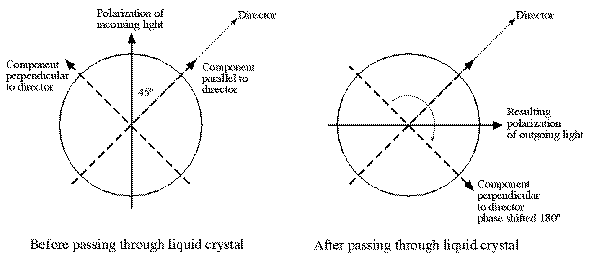


Next: Polymer-dispersed LCDs
Up: Future possibilities
Previous: Future possibilities
The surface-stabilized ferroelectric liquid crystal display
shows great promise. It uses chiral smectic liquid crystal---a
type in which the director rotates around a cone of directions
 from the perpendicular of the layers. The hope is to
make the film so thin that the director will not rotate. The planar
layers are perpendicular to the glass plates of the display. The
liquid crystal molecules have a permanent electric dipole
perpendicular to the long axis of the molecule (the director). When a
positive electric field is applied across the film, the dipole wants
to align toward one of the glass plates. This makes the director
point a particular direction that is parallel to the glass plates.
When the opposite electric field is applied, the dipole will rotate
from the perpendicular of the layers. The hope is to
make the film so thin that the director will not rotate. The planar
layers are perpendicular to the glass plates of the display. The
liquid crystal molecules have a permanent electric dipole
perpendicular to the long axis of the molecule (the director). When a
positive electric field is applied across the film, the dipole wants
to align toward one of the glass plates. This makes the director
point a particular direction that is parallel to the glass plates.
When the opposite electric field is applied, the dipole will rotate
 to point the other direction. The director will then be
to point the other direction. The director will then be
 away from where it used to be.
away from where it used to be.
If the entering light is polarized along the director in one of these
states, then no light will be able to penetrate a crossed polarizer on
the other side. When the molecule is rotated, the polarization of the
light will be at a 45 degree angle to the director. This means that
the two components of the light, one parallel and one perpendicular to
the director, will travel at different speeds through the liquid
crystal. If the thickness can be controlled so that the component
perpendicular to the director will be  out of phase from
where it started, then the resulting light's polarization will be
rotated
out of phase from
where it started, then the resulting light's polarization will be
rotated  and will be able to penetrate through the crossed
polarizer.
and will be able to penetrate through the crossed
polarizer.

Figure 6: Modification of polarization by ferroelectric
displays. Before passing through the liquid crystal, the
components of light polarized parallel and perpendicular to
the director can be separated. After passing through the
liquid crystal film, the perpendicular component is shifted in
phase by  . The resulting linear polarization is
rotated
. The resulting linear polarization is
rotated  from its original direction.
from its original direction.
Surface-stabilized ferroelectric displays have the distinct advantage
that switching speeds are very high since electric field is necessary
for both turning a pixel on and for turning it off. However, problems
in development of this kind of display have persisted. The most
difficult issue to resolve has been the orientation of the director
throughout all the layers of the film. As said before, the director
normally rotates around a cone of directions as we move through the
layers of the crystal, but if this display scheme is to work, this
rotation must be stopped.



Next: Polymer-dispersed LCDs
Up: Future possibilities
Previous: Future possibilities
Stefan Agamanolis
Thu May 18 11:00:12 EDT 1995
 from the perpendicular of the layers. The hope is to
make the film so thin that the director will not rotate. The planar
layers are perpendicular to the glass plates of the display. The
liquid crystal molecules have a permanent electric dipole
perpendicular to the long axis of the molecule (the director). When a
positive electric field is applied across the film, the dipole wants
to align toward one of the glass plates. This makes the director
point a particular direction that is parallel to the glass plates.
When the opposite electric field is applied, the dipole will rotate
from the perpendicular of the layers. The hope is to
make the film so thin that the director will not rotate. The planar
layers are perpendicular to the glass plates of the display. The
liquid crystal molecules have a permanent electric dipole
perpendicular to the long axis of the molecule (the director). When a
positive electric field is applied across the film, the dipole wants
to align toward one of the glass plates. This makes the director
point a particular direction that is parallel to the glass plates.
When the opposite electric field is applied, the dipole will rotate
 to point the other direction. The director will then be
to point the other direction. The director will then be
 away from where it used to be.
away from where it used to be.



 out of phase from
where it started, then the resulting light's polarization will be
rotated
out of phase from
where it started, then the resulting light's polarization will be
rotated  and will be able to penetrate through the crossed
polarizer.
and will be able to penetrate through the crossed
polarizer.

 . The resulting linear polarization is
rotated
. The resulting linear polarization is
rotated  from its original direction.
from its original direction.